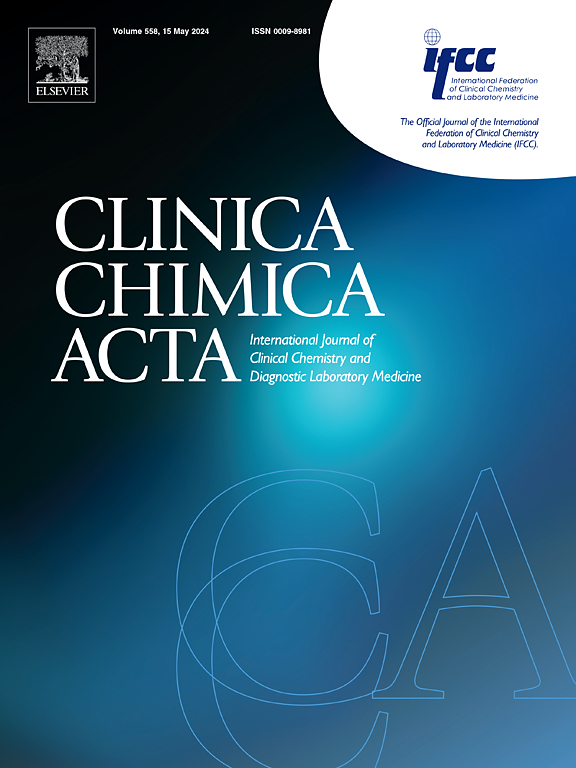The value of midregional proadrenomedullin to predict mortality in intensive care unit
IF 3.2
3区 医学
Q2 MEDICAL LABORATORY TECHNOLOGY
引用次数: 0
Abstract
Aim
This study explores the value of midregional proadrenomedullin (mr-proADM), C-reactive protein (CRP), procalcitonin (PCT), and presepsin (PSP) in predicting mortality, considering both their absolute values at different time points and their dynamic kinetics.
Methods
We conducted a retrospective observational study including all consecutive adult ICU admissions. Biomarkers were measured at admission (T0), day 3 (T3), and day 5 (T5). We assessed absolute values, relative variations, and categorized changes (≥50 % increase or decrease).
Results
A total of 99 patients were included. mr-proADM at T3 had the highest predictive value for ICU mortality (AUC = 0.77), followed by PSP at T3 (AUC = 0.70). Cox regression identified mr-proADM at T3 as an independent predictor of mortality (HR: 1.16, p < 0.001), with a ≥ 50 % increase in mr-proADM from T0 to T3 significantly associated with mortality risk (HR: 4.15, p < 0.001). In patients with low baseline mr-proADM levels, a ≥ 50 % increase at T3 was significantly associated with mortality (HR: 4.43, p = 0.04), while in those with high baseline levels, the absolute value at T3 was more predictive.
Conclusion
Our findings suggest that mr-proADM at T3 is the most informative biomarker for predicting ICU mortality, with its absolute value and dynamic increase providing valuable prognostic insights. Importantly, stratified analysis highlights that different risk stratification approaches may be necessary based on baseline mr-proADM levels.
目的 本研究探讨了中区域前肾上腺髓质素(mr-proADM)、C 反应蛋白(CRP)、降钙素原(PCT)和前胃蛋白酶(PSP)在预测死亡率方面的价值,同时考虑了它们在不同时间点的绝对值及其动态动力学。生物标志物在入院时(T0)、第 3 天(T3)和第 5 天(T5)进行测量。我们评估了绝对值、相对变化和分类变化(增加或减少≥50%)。结果 共纳入了99名患者。T3时的mr-proADM对ICU死亡率的预测值最高(AUC = 0.77),其次是T3时的PSP(AUC = 0.70)。Cox回归发现,T3时的mr-proADM是死亡率的独立预测因子(HR:1.16,p <0.001),从T0到T3,mr-proADM增加≥50%与死亡风险显著相关(HR:4.15,p <0.001)。结论我们的研究结果表明,T3 时的 mr-proADM 是预测 ICU 死亡率最有参考价值的生物标志物,其绝对值和动态增加提供了有价值的预后见解。重要的是,分层分析表明,根据 mr-proADM 的基线水平可能需要采取不同的风险分层方法。
本文章由计算机程序翻译,如有差异,请以英文原文为准。
求助全文
约1分钟内获得全文
求助全文
来源期刊

Clinica Chimica Acta
医学-医学实验技术
CiteScore
10.10
自引率
2.00%
发文量
1268
审稿时长
23 days
期刊介绍:
The Official Journal of the International Federation of Clinical Chemistry and Laboratory Medicine (IFCC)
Clinica Chimica Acta is a high-quality journal which publishes original Research Communications in the field of clinical chemistry and laboratory medicine, defined as the diagnostic application of chemistry, biochemistry, immunochemistry, biochemical aspects of hematology, toxicology, and molecular biology to the study of human disease in body fluids and cells.
The objective of the journal is to publish novel information leading to a better understanding of biological mechanisms of human diseases, their prevention, diagnosis, and patient management. Reports of an applied clinical character are also welcome. Papers concerned with normal metabolic processes or with constituents of normal cells or body fluids, such as reports of experimental or clinical studies in animals, are only considered when they are clearly and directly relevant to human disease. Evaluation of commercial products have a low priority for publication, unless they are novel or represent a technological breakthrough. Studies dealing with effects of drugs and natural products and studies dealing with the redox status in various diseases are not within the journal''s scope. Development and evaluation of novel analytical methodologies where applicable to diagnostic clinical chemistry and laboratory medicine, including point-of-care testing, and topics on laboratory management and informatics will also be considered. Studies focused on emerging diagnostic technologies and (big) data analysis procedures including digitalization, mobile Health, and artificial Intelligence applied to Laboratory Medicine are also of interest.
 求助内容:
求助内容: 应助结果提醒方式:
应助结果提醒方式:


